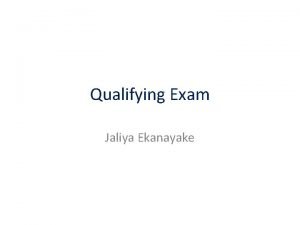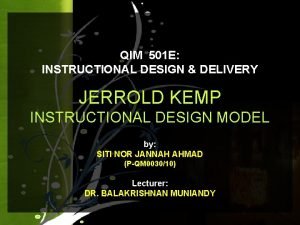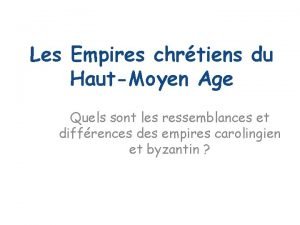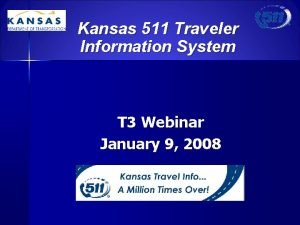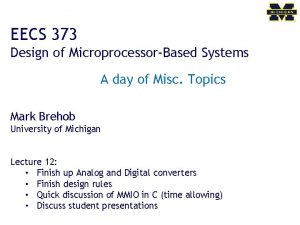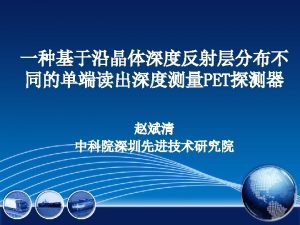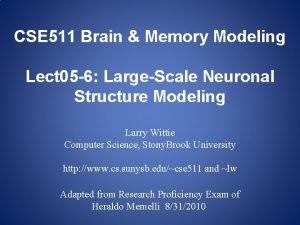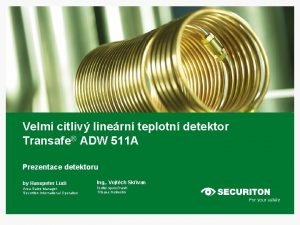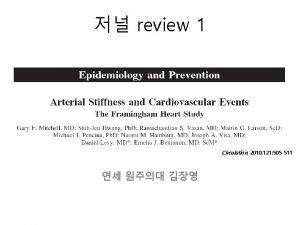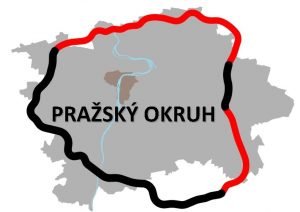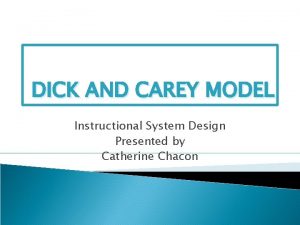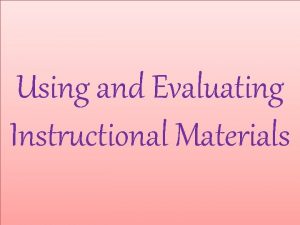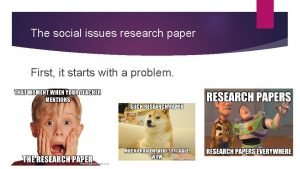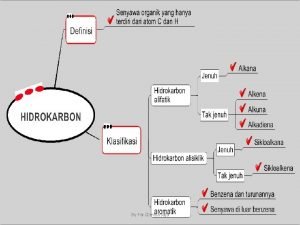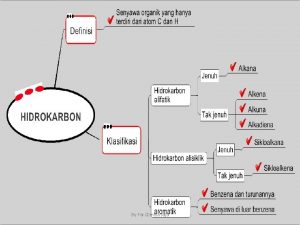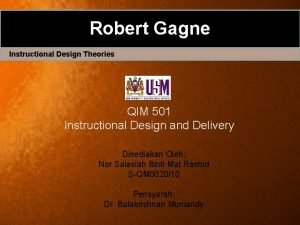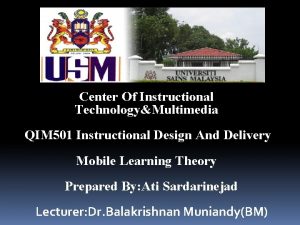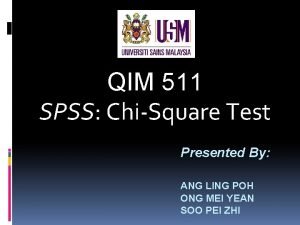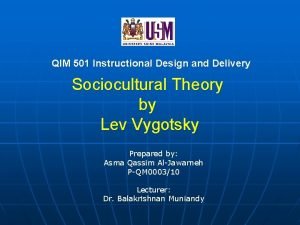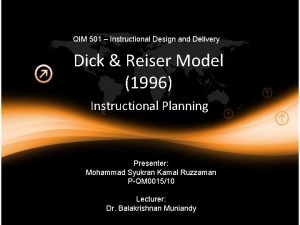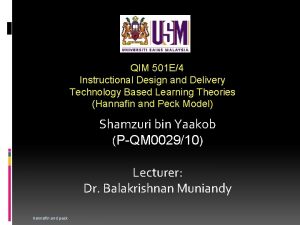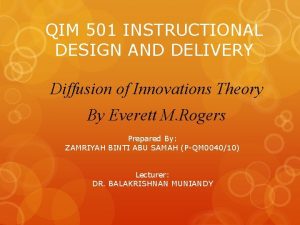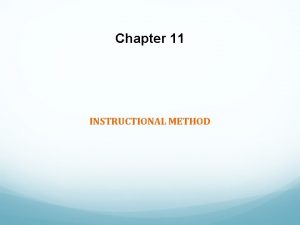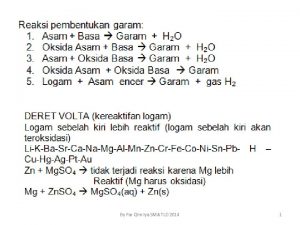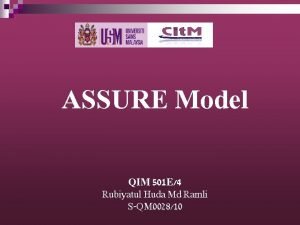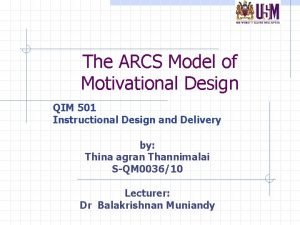QIM 511 Research Method and Issues in Instructional























- Slides: 23

QIM 511 Research Method and Issues in Instructional Multimedia Statistical Test T-Test for Independent Samples By: Rosli Che Din Mohamed Zamri Mohd Zain Mohammad Syukran Kamal Ruzzaman Lecturer: Dr. Balakrishnan Muniandy

History The t-statistic was introduced in 1908 by William Sealy Gosset, a chemist working for the Guinness brewery in Dublin, Ireland. Gosset devised the t-test as a way to cheaply monitor the quality of stout. He published the test in Biometrika in 1908, but was forced to use a pen name (Student) by his employer, who regarded the fact that they were using statistics as a trade secret. Hence the test was named as Student's t-test. Rosli, Zamri & Syukran (2011) – t-Test for Independent Samples

Three Types of Independent Test • One-sample t-test : Used to compare a sample mean with a known population mean or some other meaningful, fixed value • Independent samples t-test : Used to compare two means from independent groups • Paired or dependent samples t-test: Used to compare two means that are repeated measures for the same participants - scores might be repeated across different measures or across time. Used also to compare paired samples, as in a two treatment randomized block design. Rosli, Zamri & Syukran (2011) – t-Test for Independent Samples

When to use it? • Perform hypothesis tests concerning the difference in means of two independent populations Rosli, Zamri & Syukran (2011) – t-Test for Independent Samples

Assumptions of data • All observations must be independent of each other • The dependent variable must be measured on an interval or ratio scale • The dependent variable must be normally distributed in the population (for each group being compared). (NORMALITY ASSUMPTION) • The distribution of the dependent variable for one of the groups being compared must have the same variance as the distribution for the other group being compared. (HOMOGENEITY OF VARIANCE ASSUMPTION) Rosli, Zamri & Syukran (2011) – t-Test for Independent Samples

Procedures • • • Step 1: Stating the hypotheses Step 2: Checking the assumptions Step 3: Calculate the test statistic Step 4: Evaluate the result Step 5: Interpret the result Rosli, Zamri & Syukran (2011) – t-Test for Independent Samples

Sample data • Comparing means difference score between two group of student with different learning medium. Group 1: Audio 24 13 23 17 16 20 17 19 15 26 Group 2: Text 18 31 19 29 23 26 29 30 21 24 Rosli, Zamri & Syukran (2011) – t-Test for Independent Samples

Step 1: Stating the hypotheses and rejection criteria • Research Question: Does type of learning medium affect scores? • State Statistical Hypothesis: Non Directional: H 0: µ audio = µ text H 1: µ audio µ text Directional: H 0: µ audio > µ text H 0: µ audio ≥ µ text • State Statistical Hypothesis: • Compute degrees of freedom (df = • Set alpha level (normally 0. 05) Rosli, Zamri & Syukran (2011) – t-Test for Independent Samples )

Step 2: Checking the assumptions: • To ensure that the observations are independent, make sure that each participant contributes their own data uncontaminated by other’s score. • Make sure the data in interval or ratio scale in questionnaire design. • The homogeneity assumption is checked in SPSS by Levene's test while nomality by bell shape or box plot. (Examine skewness and kurtosis (peak) of distribution) Rosli, Zamri & Syukran (2011) – t-Test for Independent Samples

Step 3: Calculate the test statistic (formula): Whereby: n: Sample size : Sample mean s 2 = variance subscript 1 = sample 1 or group 1 subscript 2 = sample 2 or group 2 Rosli, Zamri & Syukran (2011) – t-Test for Independent Samples

Step 3: Calculate the test statistic (SPSS • One-sided hypothesis • Equal or unequal variances (Levene’s) • P-value is very small, reject null hypothesis (less than. 05) Rosli, Zamri & Syukran (2011) – t-Test for Independent Samples

Step 4: Evaluate the result: • The output indicates that the observed difference in the means is significant t(1. 708) = -12. 347, p =. 000, which is smaller than α 0. 05, hence, we reject H 0 in favour of H 1. Reject the null hypothesis and conclude that there is a statistically significant difference between the two groups on the dependent variable, t = , p < α. Rosli, Zamri & Syukran (2011) – t-Test for Independent Samples

Step 4 Step 5: Interpret the result: • There is a significant difference in scores in the audio learning group compared to the text group t(1. 708) = -12. 347, p =. 000 • The finding confirmed theory of cognitive load, multimedia learning that …. . • of H 1. Rosli, Zamri & Syukran (2011) – t-Test for Independent Samples

Related Research Article Rosli, Zamri & Syukran (2011) – t-Test for Independent Samples

Abstract This study sought to assess the effects of using multimedia teaching instruction versus traditional classroom instruction method on students’ Elementary Mandarin achievement in a branch campus of a public university in Malaysia. The duration of this study covered one semester (December 2007 – April 2008) and quasi-experimental design (post-test only) was used. The samples consisted of two classes of Elementary Mandarin Level II in the branch campus; one class as the control group (n=31) and the other class as the experimental group (n=34). Independence Sample T-test results showed that the students who were taught using multimedia teaching instruction demonstrated significantly higher achievement than that of the traditional classroom instruction. Additional data gathered from face-to-face interviews with a few students indicated that the students showed positive attitude and liked to learn Mandarin through multimedia teaching instruction. They indicated that their learning outcomes are more beneficial, effective and enjoyable compared to the conventional teaching. Rosli, Zamri & Syukran (2011) – t-Test for Independent Samples

Research Questions This study hopes to shed some light on the following questions: 1. Is the achievement of students learning through multimedia teaching instruction better than the achievement of students learning through the traditional instruction? 2. What is the attitude and perception of students regarding multimedia teaching instruction as a major instruction in the Mandarin class? Rosli, Zamri & Syukran (2011) – t-Test for Independent Samples

Methodology Two Group of Samples Traditional Instruction The textbook used in the control group is the book used by the students learning Elementary Mandarin Level II in the main and all the branch campuses of the university. Every chapter consists of two situational dialogues, a list of new vocabulary, and a few sentence patterns. Multimedia Teaching Instruction Did not use the textbook. This group uses multimedia CD application comprises features such as hypertext, graphics, animations and audio. The dialogues in the textbook were transfer to video clips. In addition, the instructor himself used Power. Point presentations to present the word list and sentence patterns. Rosli, Zamri & Syukran (2011) – t-Test for Independent Samples

Pre-Test Quantitative Finding A “pre-test” was carried out to determine whethere were any statistical differences between the control and experimental groups. The previous final semester examination was used for this purpose. As illustrated in Table 1, the result showed that the control group obtained 76. 96 mean score compared to the experimental group which obtained 77. 42 mean score. The mean difference is -. 46, the t =. 218, P =. 82, and this high P value indicated that the difference of the results for the control group and the experimental group was not significant (p >. 05). The result indicated that there was no significant difference between both groups. Rosli, Zamri & Syukran (2011) – t-Test for Independent Samples

Pre-Test Quantitative Finding Rosli, Zamri & Syukran (2011) – t-Test for Independent Samples

Post-Test Quantitative Finding At the end of this study, a post-test was carried out to compare the final semester examination means score of both group. The result as illustrated on Table 2 showed that the control group obtained 76. 51 mean score compared to the experimental group which obtained 82. 4 mean score. The mean difference is 6. 00. The t = -2. 70, P =. 009, and this low P value indicated that the difference of the results for the control group and the experimental group was significant (p <. 05). As such, we can say that the experimental group has higher mean scores than that of the control group, and the result is statistically significant Rosli, Zamri & Syukran (2011) – t-Test for Independent Samples

Post-Test Quantitative Finding Rosli, Zamri & Syukran (2011) – t-Test for Independent Samples

Discussion of the Qualitative Finding The pre-test result showed that before the study started, both the control and experimental group were statistically not different. Although the experimental group’s mean score is. 46 higher than the control group, the difference is not significant at p <. 05 level. After one semester of learning Elementary Mandarin course through multimedia teaching instruction, the experimental group obtained higher means score. The difference between the means scores of both groups is bigger. The mean difference of is only. 46 during pre-test, and it increased to 6. 00 for the post-test. The difference between both groups becomes statistically significant. This postulated that the learning of Elementary Mandarin course through multimedia teaching instruction has produced positive results. As such, it could be posited that multimedia teaching instruction could be used to replace traditional classroom instruction. Rosli, Zamri & Syukran (2011) – t-Test for Independent Samples

Thank You Rosli, Zamri & Syukran (2011) – t-Test for Independent Samples
 Qim scrabble word
Qim scrabble word Esther feliciano
Esther feliciano Qim far lab
Qim far lab Jerrold kemp
Jerrold kemp Qim far lab
Qim far lab Royaume de clovis en 511
Royaume de clovis en 511 Kansas 511 road conditions
Kansas 511 road conditions Eecs 373
Eecs 373 Nnn-511
Nnn-511 Kev 775
Kev 775 511
511 Goroo trip planner
Goroo trip planner Cse 511
Cse 511 Adw 511
Adw 511 Circulation 511
Circulation 511 Stavba 511
Stavba 511 Sokp 511
Sokp 511 Site:slidetodoc.com
Site:slidetodoc.com Characteristics of symposium
Characteristics of symposium Dick
Dick Concept of instructional and communication technology
Concept of instructional and communication technology Hayden smith and thomas nagel
Hayden smith and thomas nagel Social issues for research paper
Social issues for research paper Ethical consideration in experimental research sample
Ethical consideration in experimental research sample


